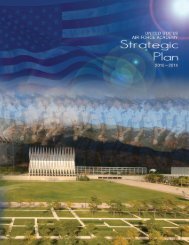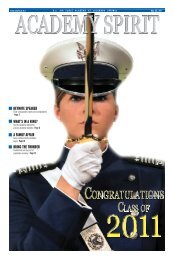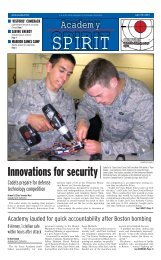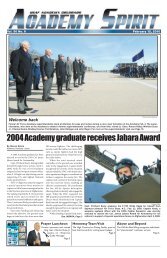2008-2009 Catalog - United States Air Force Academy
2008-2009 Catalog - United States Air Force Academy
2008-2009 Catalog - United States Air Force Academy
Create successful ePaper yourself
Turn your PDF publications into a flip-book with our unique Google optimized e-Paper software.
Chem 453. Instrumental Methods of Chemical Analysis. Advanced theory and application of modern analytical<br />
instruments for chemical analysis. Experiments include ultraviolet, visible, infrared absorption and emission spectroscopies;<br />
nuclear magnetic resonance and electron paramagnetic resonance spectroscopy; chromatography; thermal methods; and<br />
electrochemical techniques. Emphasizes hands-on experience with modern instrumentation, applications to real-world and <strong>Air</strong><br />
<strong>Force</strong> problems, computational data analysis, and modeling.<br />
Chem 465. Chemistry of Advanced Materials. Chemical studies in modern and high-tech materials emphasizing physical<br />
chemistry fundamentals, the interface between molecules and materials, and the development of these materials. Topics<br />
include chemical computational models, materials for energy storage, electronics, structures, optics, and glasses. Laboratories<br />
provide hands-on experience in synthesis and characterization of materials.<br />
Chem 481. Biochemistry I. Chemistry of living organisms emphasizing the roles played by biomacromolecules and<br />
macromolecular assemblies. Topics covered include an introduction to primary literature in biomedical research, cells and<br />
organelles, amino acids, nucleic acids, protein structures and enzymes, sugars and polysaccharides, lipids and membranes, and<br />
an introduction to metabolism.<br />
Chem 482. Biochemistry II. Chemistry of living organisms emphasizing the central metabolic processes and the<br />
transmission of genetic information. Topics covered include glycolysis and other pathways of carbohydrate metabolism, the<br />
citric acid cycle, lipid and amino acid metabolism, signal transduction, DNA replication, transcription of DNA and RNA, and<br />
translation of mRNA into protein.<br />
Chem 491. Biochemistry Laboratory. Experiments to manipulate DNA, RNA, and proteins. Techniques covered include<br />
agarose and acrylamide gel electrophoresis, recombinant DNA techniques, microbial culture and transformation, cell culture,<br />
and production and purification of recombinant proteins. Lab is designed to illustrate the conceptual principles presented in<br />
Chem 481.<br />
Chem 492. Advanced Biochemistry Laboratory. Continuation of Chem 491 which supplements material covered in Chem<br />
482. Emphasizes advanced laboratory techniques in biochemistry. Includes the use of advanced chemical instrumentation<br />
(including selections from the following: infrared spectroscopy, UV/vis spectroscopy, NMR and EPR spectrometry, differential<br />
scanning calorimetry, fluorescence spectroscopy) to problems in the life science arena. Techniques learned in Chem 482 will be<br />
applied to current problems in the biochemistry literature.<br />
Chem 495. Special Topics. Selected topics in chemistry.<br />
Chem 499. Independent Study. Capstone course for all chemistry majors. A hands-on laboratory experience applying the<br />
culminated knowledge and skills gained in the major towards a novel research project. Individual research using state-of-the-art<br />
equipment under the direction of a faculty member. Includes use of chemical literature.<br />
70 <strong>United</strong> <strong>States</strong> <strong>Air</strong> <strong>Force</strong> <strong>Academy</strong> <strong>Catalog</strong>
















